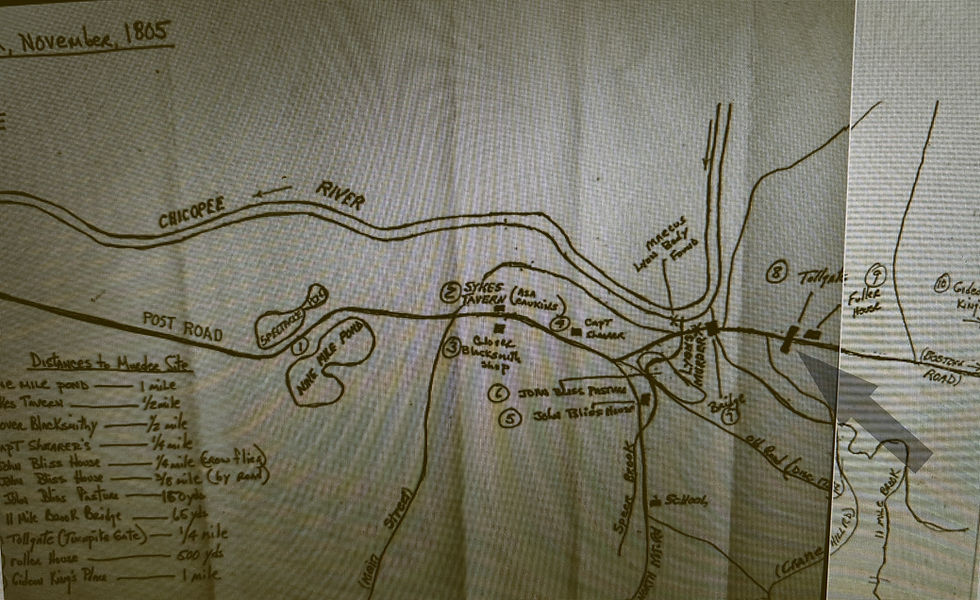Disaster on the Line: The Boston & Albany Washout of 1869
- David Bourcier
- Jun 13
- 3 min read
Updated: 3 days ago
The storm that swept through the region on October 3rd and 4th, 1869, would soon etch itself into the annals of local memory as one of the most devastating weather events at that time ever recorded in Western Massachusetts. Beginning before dawn on Sunday, torrential rain poured relentlessly through the day and deep into the night. Not until the middle of Monday afternoon did the skies finally begin to clear. For nearly two days, the rain fell not in drops but in torrents, sheets of water that seemed almost biblical in intensity.
At the U.S. Armory in Springfield, the rainfall measured an astonishing 8.05 inches between 2 a.m. Sunday and shortly after 3 p.m. Monday. To put this into perspective, this was more than double the average monthly rainfall delivered in just 37 hours. The downpour far exceeded any storm in the preceding 22 years of weather records, even surpassing the June 1858 storm.
The consequences were swift and dramatic. Train service from Albany was entirely halted, and while trains between Springfield and Boston continued running until midday Monday, the afternoon eastbound express was brought to an unexpected halt in Wilbraham. Just a half mile beyond the depot, a modest brook had transformed into a violent flood. No longer contained by its culvert, the raging water ripped out 200 feet of track and carved a gaping chasm, some parts plunging 50 feet deep.
Conductor Whitney wisely returned the train to Springfield. That evening, a construction train equipped with large headlights was dispatched to assess the damage and begin repairs. Meanwhile, other sections of the Boston & Albany line, particularly near Palmer, also reported serious damage. All through traffic in both directions came to a standstill as crews scrambled to understand the full scope of destruction.
By Tuesday afternoon, the first eastbound train since Monday morning was finally able to depart Springfield. It consisted of thirteen cars and carried roughly 700 eager passengers. Upon reaching North Wilbraham, passengers disembarked and faced a detour, either by omnibus or on foot, to bypass the washout. Most chose the more adventurous route, walking along the torn-up track toward the chasm. They crossed down the muddy embankment, balanced over the swollen brook on makeshift planks and beams, and scrambled up the opposite side, resembling mountaineers more than train travelers.

Despite the hardship, spirits remained high. Men, women, children, and even pets crossed safely with all manner of bags, bundles, and birdcages in tow. The group gathered on the green fields near Butler’s Crossing, turning the unexpected layover into a cheerful impromptu picnic. As night fell and temperatures dropped, passengers built three large bonfires, constructed from nearby farm fencing, to stay warm. Flames lit up the night sky, creating both comfort and spectacle.
The long-awaited train from Boston finally arrived around 8 p.m., met with enthusiastic cheers. A rare and joyous scene followed as strangers, westbound and eastbound, greeted one another like long-lost friends. After a lively transfer, the westbound group departed in omnibuses, while the eastbound passengers boarded their train and continued. It was nearly midnight when they finally arrived in Springfield, marking the end of a remarkable and trying journey.
By Wednesday, the railroad’s reconstruction crews had made astonishing progress. A temporary trestle bridge at the Wilbraham break was completed by 12:30 p.m., just in time for an engine and platform car to test it, moments before Conductor Whitney’s Boston-bound train arrived. The test was successful, and trains began running again in both directions with minimal delay.

Elsewhere, temporary repairs kept the line operational, if limited. Between Palmer and West Brookfield, only one track at a time could be used. Despite this, seven freight trains that had been stranded between Warren and Brimfield were finally able to reach Palmer on Wednesday afternoon, ready to resume their westward journeys.
The Great Washout of 1869 remains one of the most dramatic weather events in the region’s railroad history, an unforgettable reminder of nature’s power and the resilience of the people determined to press onward, even when the tracks beneath them gave way.





Comments